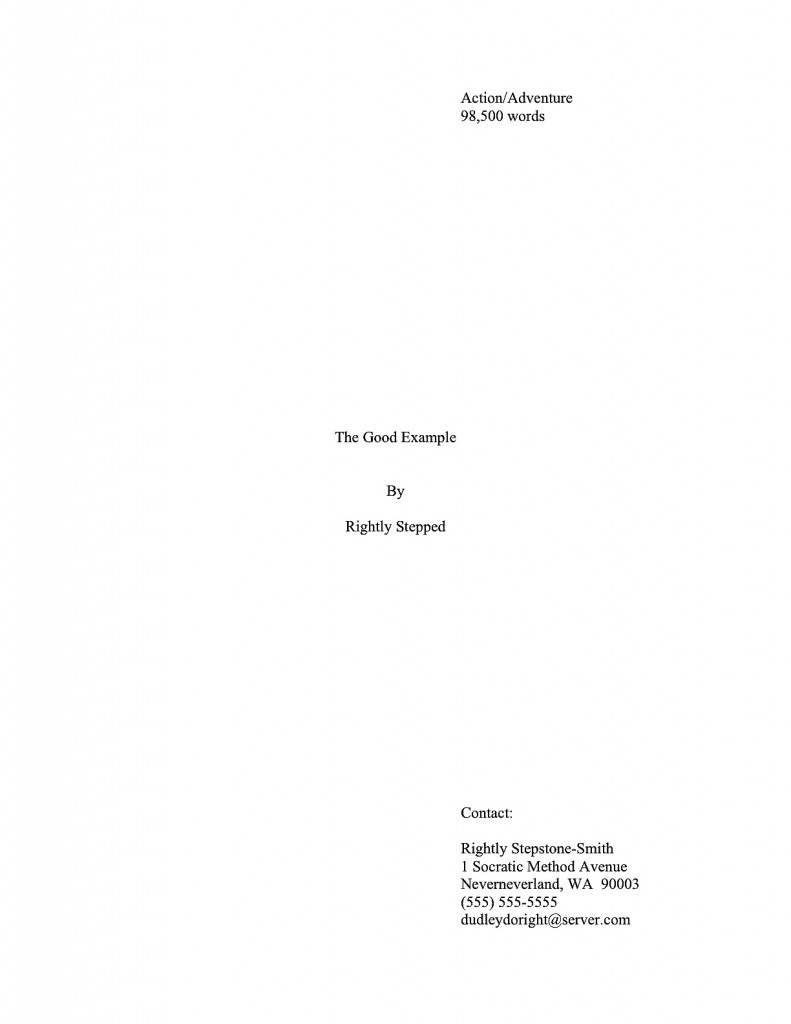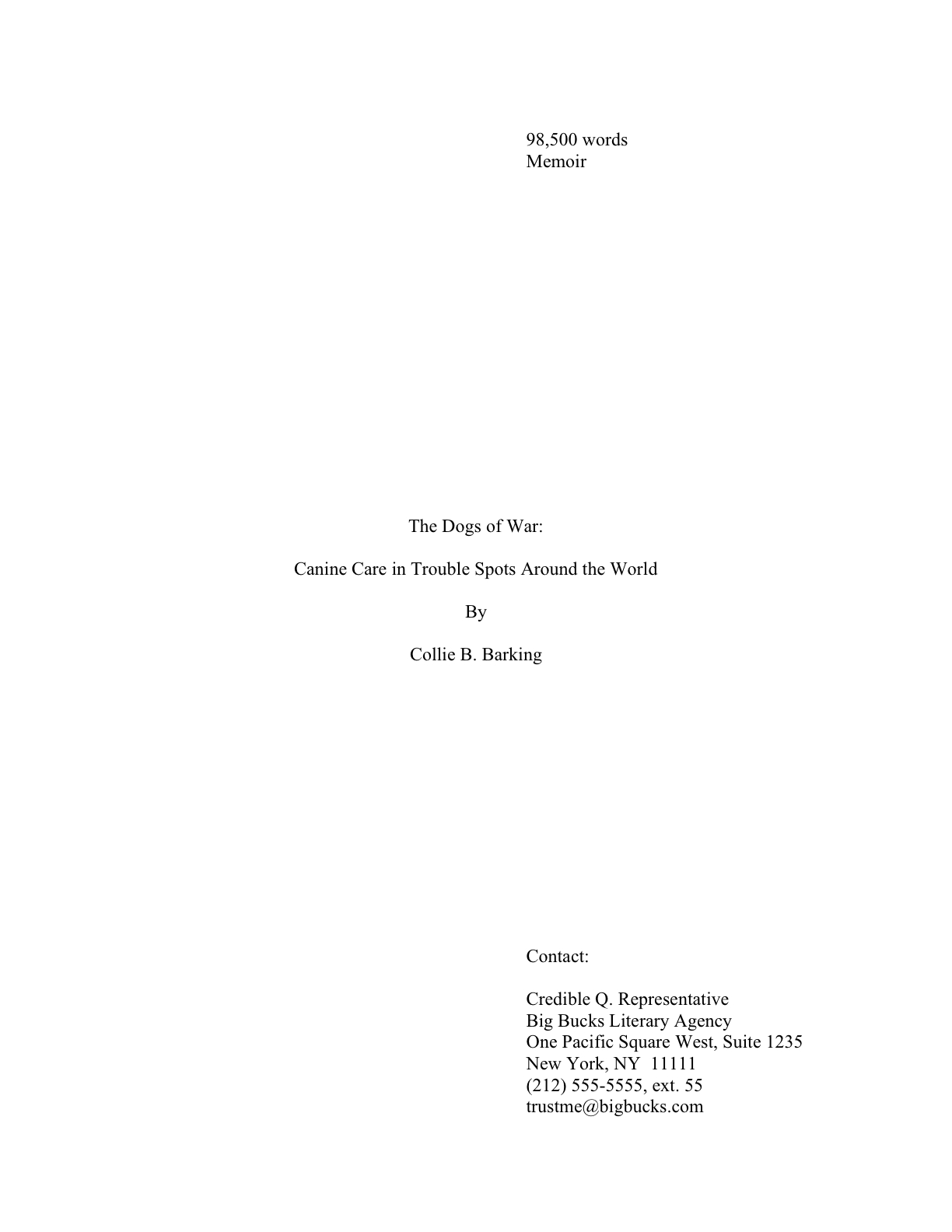I had to laugh yesterday, campers: as so often happens here at Author! Author!, everyday life rushed to provide a perfect metaphor for something we had been discussing here on this very forum. Or, more accurately in this case, something about which I had been blogging extensively, while scores of aspiring writers read silently — and a tiny minority buttonholed me privately to try to discuss offline. Take a gander at what popped into my inbox:
I have parts of your blog and am thankful for your July 25, 2012 post regarding proper ms format. I just have a couple other questions that I didn’t see addressed in your post. If you could help me on this I would be greatly appreciated.
1. I have a finished memoir, just doing editing now from my printed copy. I am not sure how to deal with dialogue. I know obviously it is in quotes, me talking to someone or someone telling me something, but what I am not sure about is the format this dialogue should be in the ms itself. ie: is each speaking part on a separate line? or just within the paragraphs and continued on with the rest of the story afterwards?
2. And I know you mention this a little in your post, but I have a lot of areas in my ms where I mention where I thought something, or one of my other “characters” used to say something, etc. How do I format? You mention when a character has a thought to either put it in single quotes OR say I thought. But not sure if this pertains to my situation with my memoir. Also, do I do a separate line for these instances as well?
3. for my chapters, they are a little different than a normal book, each one is going to note the year, age, etc that that particular part of the story is referring to, is it ok to have the chapter title be 2 lines, and does it need to be in all caps?
Thanks so much for any help you can provide.
Why, since I receive artless little missives like this about once per week, did this one strike me as such an apt exemplar for our ongoing series on common post-pitching and post-querying faux pas? Well, several reasons. First, I was supposed to cover every aspect of professional manuscript formatting in a single post? Admittedly, the post in question did provide a visual overview of what standard format looks like, but in it, I urged readers new to the rules to consult the HOW TO FORMAT A BOOK MANUSCRIPT category on the archive list at right for fuller explanations. In addition, the aptly-named MANUSCRIPTS AND HOW TO FORMAT THEM PROPERLY category contains a heading for DIALOGUE FORMATTING, and there was this particularly handy post on dialogue formatting? Because third, and most to the point of this series, obviously, the proper place to ask this set of questions would have been — wait for it — in the comments section of my July 25th post, would it not?
Yet this puzzled writer, like so many others, saw fit to contact me privately about it. And that, frankly, would have mystified not only most bloggers, but anyone with significant experience with the publishing industry.
Let’s take the blog-related perplexity first. Even a couple of years ago, virtually no regular blog reader would have dreamt of asking questions anyplace but the comments. Oh, some of you might have chosen to inquire in the comments section of my most recent post — also a good option, by the way — in order to engender comment amongst regular readers, rather than tying your comments to the post in question, but logically, most readers understood that if they had a beef with a publicly-displayed post, the blog format featured a comments section for a reason.
And that reason was ease of discussion. The difference between a blog and a column, after all, lies largely in formatting — in a blog, readers have ready access to a forum in which to express their opinions, gratitude, and/or criticism of a post. While in the past, readers who wanted to chime would have had to sit down and write a letter to the editor of a publication, wait to see if the editor thought that letter worthy of publication, and then wait again to see if any other reader decided to write a letter in response to that letter, all a blog reader has to do to share his thoughts publicly is to — again, wait for it — click on COMMENTS and share his thoughts publicly.
Emphasis upon publicly: before the rise of hand-held devices, few readers would have considered it either acceptable or desirable to shatter the well-established wall between public and private by e-mailing a blogger to discuss the subject matter of a post. Not only does it defeat the purpose of a blog — which is, correct me if I am wrong, to discuss issues of mutual interest in a public forum — but in a blog devoted to helping the literally millions of aspiring writers deal with the thorny and often perplexing issues of manuscript submission, it’s inefficient.
Why? Well, if a question is asked and answered in the comments, there’s a reasonable hope that someone else will benefit from the answer, right? If, by contrast, I invited (or even permitted) every single one of you to contact me offline to ask (forgive me for putting it this way, but it’s true) the same fifteen or twenty questions over and over again, I wouldn’t be a blogger — I would be a secret question-answering service.
That’s why, in case any of you had been wondering, my archive list (conveniently located on the lower right-hand side of this page) is so extensive and contains so many specific questions: since I have been at this for more than seven years, I have addressed a plethora of common concerns. Rather than reinventing the wheel, as the saying goes, for each curious reader, I have chosen in the spirit of public discussion to make those previous posts easy to find.
And just a few years ago, that would have been considered going above and beyond the obligations of a blogger. These days, however, the individual’s ability to whip out her iPhone, perform a 15-second search, and come up with at least a superficial answer to most common questions has, rather surprisingly to many of us that provide online content, has lead to a pervasive expectation that any question, regardless of complexity, should be answerable and should already have been directly answered somewhere online.
How else, after all, would one find it in a 15-second search?
Actually, I don’t have a problem with that: one of the advantages of living in the current age is ease of information access; I would not have made thousands of pages of professional insight available had I not wished to — are you tired yet of being told to wait for it? — make them available to millions of struggling writers.
That does not mean, however, that I don’t find it surprising when a reader who does not instantly find what he wants on my site — and, as in this instance, apparently does not check the archive list to see if I’ve ever dealt with the issue before — leaps to the twin conclusions that (a) I must have fallen down on the job by not having anticipated the specific question he had in mind and (b) I must therefore be willing to donate my time for a private tutorial on the subject.
Instead of, say, donating my time to the writing community at large by blogging about it in public, where not only one, but millions of aspiring writers had access to the answer.
I’m bringing this up not because I’m peevish — although you might be surprised at how often those of us that blog for aspiring writers talk among ourselves about the startling recent rise in offline demands like this. I’m aware that sometimes, readers may feel a bit awkward about posting questions on months-old posts. (To set your minds at ease on this point: my blogging program informs me whenever any reader comments on any post, no matter how old. People post questions on old posts all the time.)
Throughout this series, we have been discussing the sometimes broad, wide, and deep gap between what aspiring writers can consider acceptable in approaching agents and editors and what the pros do. And, frankly, agents and editors who blog are not the only ones who have been receiving missives like this lately. Which, to someone familiar with how the publishing industry works, is genuinely shocking.
It’s become astonishingly common for aspiring writers to send long, chatty questions to agents to whom they have pitched at conferences, for instance — or even those they have merely heard speak at one. You’d be amazed at how many queries read like demands to drop everything and pay attention to the sender. And just the other day, an aspiring writer e-mailed me triumphantly to announce that, contrary to what I have always strenuously recommended on this blog, he had picked up the phone, called the agent that represented TUESDAYS WITH MORRIE, and not immediately been rejected.
In fact, the nice person on the other end of the phone line answered his question: yes, cold-calling an agent to pitch is completely unacceptable. Who knew?
If you’ll pardon my saying so, anyone who reads this blog regularly would have. So would anyone who had taken the time to check the aforementioned extensively indexed archive list at right. Yet, like the formatting enthusiast above, the cold-caller not only did not check what I have written publicly to see if I had addressed the issue — he went out of his way to e-mail me to tell me so.
Privately. Where no other aspiring writer could possibly learn anything from the communication.
I tremble to add this, but it’s also become amazingly common for successful queriers and pitchers — you know, the ones who did take the time to learn how agencies work, made a polite approach to an agent or editor, and garnered a request for the opening pages — to expect to hear back from the requesting pros within a week or two. Or even just a few days.
That’s an unreasonable set of expectations, from a professional perspective: it’s not as though these writers’ manuscripts are the only ones that the agent or editor has requested in the last few months, right? It’s only fair that the pros would read what’s already on their desks before they turned to a newly-arrived submission. And savvy submitters know that, because — feel free to chant it with me now, campers — an agent or editor’s request for manuscript pages does not constitute a promise to drop everything and read your work.
Aspiring writers often believe otherwise, of course, but until fairly recently, norms of social behavior and high long-distance telephone rates rendered follow-up calling blessedly uncommon. In years past, these justifiably anxious submitters might have been forced to stew in their own impatience until they received either a thin letter asking for the rest of the manuscript or the return of their pages in a postally-battered SASE.
Admit it: even those of you who know better have been tempted to nag, right? That’s natural, but it’s also problematic, given the current state of technology: today, the ease of e-mail permits, if not downright encourages, gun-jumping. Many an excitable submitter has been known to stand it as long as she can, then shoot off an ill-advised message in the wee hours, demanding to know what on earth could possibly be taking so long.
And because many agents are darned nice people, she might actually receive a soothing, I’ll-get-to-it-soon reply. But fair warning, gun-jumpers: this is a response that a submitter is likely to get only once, if at all. Which is unfortunate, as many aspiring writers apparently find the ability to generate those soothing replies rather addictive. Or so I surmise, for I hear all time about — and from; had I mentioned that boundaries regarding e-mailing online advice-givers have become rather porous? — submitters who just can’t stand to wait another month. Or week. Or day.
In case I’m being too subtle here: whatever you do during what can be an extended wait to hear back about your manuscript, repress the urge to demand constant status updates. Trust me, it will not get your submission read faster — in fact, it might get your manuscript rejected on the spot.
Being pushy is not — how shall I put this? — likely to make you any friends at the agency. It’s considered quite rude for a writer to try to rush a decision, in fact. (Interesting, considering that writers often have only a week or two to decide whether to accept a publishing offer, and most agents will expect a yes or no on a representation offer right away.) It’s also not a good way to convince an agent that you’ll be a dream client: why would anyone at an agency believe that a writer that e-mails four times in a two-month period to try to find out if the agent has decided whether to represent a manuscript won’t do precisely the same thing if and when that agent is circulating that manuscript to publishing houses — a process that often takes months, if not years?
Oh, should I have warned you that one was coming? Crunching a dry cracker should help with the nausea.
I bring this up advisedly, because the often vast differential between writers’ expectations and publishing realities can, and increasingly frequently does, lead inexperienced pitchers, queriers, and submitters to believe, wrongly, that directly and forcefully contacting an agent or editor is not only acceptable, but appropriate. And as those of you who attend writers’ conferences or read agents’ blogs are probably already aware, people who handle manuscripts for a living tend not to be all that fond of being hounded, nagged, or otherwise blamed for — were you already waiting for it — not dropping everything to pay attention to any particular aspiring writer.
Fortunately, the genuinely rude are relatively rare; as those of us that work with aspiring writers like to say, 99.99% of the pros’ perennial complaints about how pushy writers are actually refer not to the ten thousand who approach respectfully, but the one who does not.
And that one, in my experience, tends to be brand-new to the game — and harboring the astoundingly popular misconception that a really good manuscript from a first-time writer is uncommon enough that the pros will want to be disturbed at work to hear about it. Or, now that e-mail makes disturbing total strangers so darned convenient, rousted in the dead of night to read a pitch.
Or — you saw this coming, right? — to answer a question from a writer they’ve never met, one who evidently doesn’t realize that there are literally millions of aspiring writers who want to get published every bit as much as she does. From a professional perspective, then, this type of approach is simply queue-jumping: rather than doing what pretty much every successful author has had to do, learn how the publishing industry actually works and abide by its quite strict rules of conduct, the dead-of-night e-mailer or spur-of-the-moment caller believes, wrongly, that those rules don’t apply to him.
He has talent, so how could they? And had he mentioned how much he wants to get his manuscript published?
Which, admittedly, is not a new thing for first-time writers to think — I can’t think of a time in modern publishing history when agents and editors did not complain of constantly receiving pay attention to me now! missives — but the technology that enables them to act upon these beliefs is. What’s interesting about the rise of e-mailed pushiness, I think, is not that there are so many impatient aspiring writers, or that a hefty swathe of them should have come to believe that it’s the pros’ job to drop everything to hear pitches or answer questions but how often these attempts appear to be the sender’s first attempt to track down the information.
How can we tell? Well, let’s take another peek at the undoubtedly well-intentioned questions my dead-of-night e-mailer sent me.
1. I have a finished memoir, just doing editing now from my printed copy. I am not sure how to deal with dialogue. I know obviously it is in quotes, me talking to someone or someone telling me something, but what I am not sure about is the format this dialogue should be in the ms itself. ie: is each speaking part on a separate line? or just within the paragraphs and continued on with the rest of the story afterwards?
2. And I know you mention this a little in your post, but I have a lot of areas in my ms where I mention where I thought something, or one of my other “characters” used to say something, etc. How do I format? You mention when a character has a thought to either put it in single quotes OR say I thought. But not sure if this pertains to my situation with my memoir. Also, do I do a separate line for these instances as well?
3. for my chapters, they are a little different than a normal book, each one is going to note the year, age, etc that that particular part of the story is referring to, is it ok to have the chapter title be 2 lines, and does it need to be in all caps?
From a professional perspective, these are rather revealing questions. First, my nocturnal e-mailer must be brand-new to submitting memoir, at least to US-based agencies: not only does she refer to the characters in her memoir as “characters,” as if characters existed only in fiction, but in this country, the overwhelming majority of memoir is not sold on a finished manuscript, but upon a book proposal. While some agencies do ask first-time memoirists to see a full manuscript first, that’s because it’s often emotionally very difficult to complete a memoir; the human psyche, after all, does not make a huge distinction between reliving an experience vividly enough to write about it well and living through it directly. The pros want to make sure someone new to the game is already dealing with that.
Then, too, questions (1) and (2) might have been answered by opening not only virtually any published memoir, but most published books. My guess here, then, is that what the sender was actually asking here is not a question about dialogue formatting per se. I think she really wanted to know is whether there is a special dialogue format for memoirs, or perhaps for first-person narratives in general.
The answer to that one is short, sweet, and could easily have been answered in the comments on that post: no. Dialogue is dialogue, period.
The question about thought would also raise eyebrows for another couple of reasons: in a first-person narrative, the narrator’s thought is generally presented as just part of the narrative; if everything in the book is from the memoirist’s perspective, it’s hardly necessary to keep informing the reader of the fact. And in a first-person narrative, of course, it’s impossible to cite the thought of any character other than the narrator, right? If the narrative is quoting somebody else’s speech, that’s dialogue, not thought.
And, while we’re being technical, would I be too editorial-minded of me to point out that I have literally never advised any aspiring writer formatting a work for the U.S. market to use single quotation marks for thought? Or, indeed, for anything purpose other than designating a quote within a quote, for the exceedingly simple reason that it’s incorrect in American English?
Before we go into the horrifying possibility that my e-mailer contacted me about some other writing guru’s advice, let’s once again go over this often-misunderstood piece of punctuation. Contrary to popular belief amongst aspiring writers, single quotation marks (‘) do not carry a special meaning in American English, nor is using them instead of italics to emphasize a word or phrase proper. Nor is the decision to use single quotation marks (‘) or the American standard double (“) a stylistic one, ever. So how may a single quotation mark be used in American English? In only one manner: when a character quotes something someone else has said. In that instance, the overall quote falls within doubled quotation marks, and with the single quotes designating what the speaker is saying someone else has said. As in:
“Well, then Antonio saw me and yelled, ‘Hey, get out of here,’ and I ran away,” Ellen explained. “But not before I shouted over my shoulder, ‘Watch out for the rampaging tiger behind you!’”
My point about the two — and only two — means of correctly formatting thought in a text has absolutely nothing to do with this. As, indeed, one might surmise from the fact that in the post in question, I specifically said not to place thought within quotation marks, as Jane Austen did; it’s exceedingly old-fashioned, and it obviates the point of quotation marks, which is to indicate to the reader that something was uttered out loud.
Or, to put it another way, thought is not dialogue. Easy to remember, isn’t it?
What I did say, as it happens, is that it drives Millicent the agency screener — and, indeed, any classically-trained professional reader — completely nuts when she sees thought designated redundantly on the page. It’s always proper to designate thought with — five, six, seven, eight — the phrase I thought, of course. However, in some book categories (not all; check recent releases in yours), it is also considered acceptable to use italics to show what is being thought, as opposed to said. Thus, both of these would be correct in standard format:
I’ll never come here again, Hermione thought, slamming the door behind her.
I’ll never come here again. Hermione slammed the door behind her.
Makes sense, right? Since Hermione thought and the italics are intended to convey precisely the same thing to the reader, this formulation would be redundant:
I’ll never come here again, Hermione thought, slamming the door behind her.
Everybody clear on that? Excellent. Now let’s return to the question that’s probably been burning in my mind far more than in yours: did my e-mail correspondent mix my advice up with somebody else’s — and is that what she actually meant when she mentioned that I have parts of your blog? Did some well-meaning but organizationally challenged third party copy excerpts of my formatting run-downs without my permission (a copyright violation, by the way), throw them into a bowl with bits of other online advice, stir, and hand it to our question-asking friend?
Or — and this seems to happen quite often to writers who glean most of their writing guidelines online — has simply read so many different and probably mutually contradictory sources that she has concluded that I was advising something quite far removed from what I actually recommended?
Either way, no wonder she was confused. Again, I could simply refer her to the extensive explanations and many visual aids under the HOW TO FORMAT A BOOK MANUSCRIPT category, but I honestly would like to figure out what happened here. Here’s the example I used in the post she cites, a page in standard format, with all of its constituent parts labeled:
And here is her question:
3. for my chapters, they are a little different than a normal book, each one is going to note the year, age, etc that that particular part of the story is referring to, is it ok to have the chapter title be 2 lines, and does it need to be in all caps?
See the problem? The example shows a two-line chapter heading — and nothing on this page is in all-caps formatting. Nor do any of the other examples I include in that post feature all-caps formatting; conscientiously, I went back and checked, although to the best of my recollection, I have never advised its use for a title.
Why would I? It wouldn’t be proper in standard format. We must reluctantly conclude, then, that my late-night correspondent was in fact asking about somebody else’s advice.
Again, I’m bringing this up not to be peevish, or even to call her out for disturbing my night with a question she fairly clearly should have been aiming at someone else; mixing up online writing advice is much more common than any of us who habitually give such advice might hope. That’s to be expected, given how much self-described expert advice is floating around out there and how many aspiring writers engage in 15-second searches of it. What is surprising is that, being confused, she approached me offline with her questions about it.
Now, we could easily get all Freudian about motivation here — is it possible that she contacted me privately because she was aware that she wasn’t entirely sure of the source of her confusion, and if so, have I completely defeated that purpose by discussing it in public? — but this is a practical blog: I am far more concerned about writers’ actions than their intentions. This e-mail caused me to worry, then, not only about how my correspondent and all of the many, many aspiring writers like her are acquiring and processing formatting and submission information, but what they might do with it.
Specifically, about whether anything about this missive would be likely to get this obviously well-meaning writer in trouble if she sent something similar to an agent. And the answer is yes.
Half of you just rolled your eyes, didn’t you? “Please don’t tell me again to ‘wait for it,’ Anne,” the more experienced submitters among you scoff, “although, naturally, I relish the opportunity to demonstrate that I am adept at using quotes within quotes. You’ve already made the point — and quite forcefully, too — that as charming and addictive as those 15-second searches can be, they might not always be the best means of finding reliable information upon subjects as inherently complex as successful writing, manuscript formatting, querying, and/or submission. You’ve also already explained, albeit indirectly, that just because it’s possible to discover a publishing professional’s e-mail address online doesn’t mean that it’s necessarily a good idea to use it in the dark of night. Or any other time, for that matter. But I can’t help but feel that few of us who have read through this post are likely to succumb to that temptation anytime soon — and that those of us who have been submitting for a good, long while already know better. So what may I, a reader that would never even consider snatching up a phone and calling an agent I have never met or sending repeated, nagging e-mails to one that has my submission, learn here?”
Well, a couple of things — but you’re right that most of this post has been aimed at those that are new to the biz. Frankly, the question of whether it’s okay to approach an agent or editor informally — or to cold-call them at all — is just not one that would occur to someone who has been hanging around publishing for long. Since agents and editors do not pick up new writers that way, to us, it’s a self-evidently self-defeating tactic.
Or, to put it a bit more bluntly, there’s a reason that e-mails like this are seldom answered at all. In a world with rapidly-dissolving boundaries, the sub-world of books remains a place where manners count. Thank goodness.
I do have an ulterior motive for devoting a post within this particular series to the all-too-common problem of writers assuming that any publishing pro that’s nice to them, or even seems from afar to be approachable, is going to be willing to give private advice. In the first place, one does not have to work in publishing very long to be aware that there are literally millions of aspiring writers out there — as queriers and submitters so often lament, sheer volume prevents most agencies from having the time to respond individually to each. Heck, it’s become downright common for agencies not to tell a submitter at all if they’ve rejected a manuscript.
Yes, even if they requested the whole thing. From the writer’s perspective, one of the side effects of the astronomical increase of submission spurred by the wide use of personal computers has been that her submission’s getting rejected and simply having gotten lost, either in the mail or at a paper-laden agency, looks remarkably similar. I’m afraid that there’s little that aspiring writers can do about that, other than to send a single, well-mannered e-mail a few months after the manuscript has arrived at the agency, politely double-checking that it did in fact arrive in one piece.
If that e-mail does not elicit a reply, the only sensible course is to assume that it’s been rejected and move on. Again, as tempting as it may be to presume that having been asked to send pages has given a writer some rights, repeated or nagging e-mails are unlikely to help your case.
Yes, yes, I know: it’s a bitter pill to swallow. Ready for one that might be even harder to choke down?
Brace yourself, please: greater experience submitting — or even attending writers’ conferences, which tends to accelerate a writer’s learning curve about how the industry works — will not necessarily help an aspiring writer avoid the problems of over-familiarity or less-than-reasonable expectations. And that’s unfortunate, because just as the pros assume that any writer serious about getting published will take the time to learn how professional book manuscripts are put together — a presumption so pervasive that few agencies even list the strictures of standard format on their websites, speaking of things that might not pop up in a 15-second search — agents and editors tend to believe that any new writer accomplished enough to write beautiful prose will have learned along the way how submission works.
Find that hard to believe? When’s the last time you heard an agent say at even a very good literary conference, “Look, we have mountains of requested materials to read. If we asked for it, we are interested, but the idea that we would be ready to make an offer of representation on a manuscript we received a week ago is pretty laughable. Unless, of course, the book was written by a celebrity, there’s a clear pop culture demand for a book on that particular subject AND the writer happens to be an expert, or the writer’s just done awfully well in a prestigious writing contest. Or if I happen to be stuck on an airplane with nothing else to read, and you’re my college roommate’s ne’er-do-well younger brother. Otherwise, be prepared to wait.”
That’s all likely to be true, but it would be an extremely unwise speech to give at a writer’s conference, wouldn’t it? The attendees might well rush the stage, perhaps after first snatching up any torches and pitchforks that happened to be handy.
Because good writers so often send off their manuscripts without any clear notion of how long it might be before they are likely to see them again — if, indeed, they will see those pages again at all — and because successful pitchers in particular are prone to tumbling into the trap of believing that a nice conversation with an agent or editor at a conference implies both the beginning of a friendship and an implicit promise to toss aside whether happens to be on the pro’s desk to read their submissions the instant they arrive, I’m going to share one more case study before I sign off for the day. To be candid, the writer in this situation is someone of whom you have probably heard; he’s now a pretty well-established author. He finally gave in to my two years of blandishments to allow me to use his story here on the blog only if I changed enough details to render him unrecognizable.
So don’t even try. Just keep his fame in the back of your mind as you read his tale of woe and uproar, to remind you that no matter how talented a writer might happen to be, it’s easy to get sucked into unreasonable expectations. Not to mention unreasonable hopes.
And his story, too, begins with an e-mail I received in the dead of night. I had known Teddy — not his real name, naturally; nice try, guessers — for years before he got his first break; it’s actually not all that uncommon for writers that end up getting published to have met on the writers’ conference circuit. (Yet another reason that it’s a good idea to attend them: no one, but no one, will understand your joy at finally landing an agent or selling your first book than a fellow writer who has been rooting for you since you shared the last bagel on a conference breakfast buffet.) Yet this was the first time he had ever e-mailed me in a panic.
Bear with me here, because I have something to confess. Remember those agents you suggested I query if my pitches didn’t work out? Well, I have not yet contacted them because Respected P. Editorvich from Arewe, Literate, & How had asked me to send my book directly to him. Dream agency, dream connection, right?
I sent him the manuscript last September. I gritted my teeth until May of this year, then I e-mailed him. He said that he loved what he had read thus far, but had misplaced the book during a move! Okay, it happens. I resubmitted, telling him that I wanted my book in his hands.
That was five weeks ago. Last week, I sent him an e-mail asking about the book, but I haven’t heard back from him. At this point, I don’t know how to handle the situation. I’m a newbie in the confusing world of publication.
Do you mind if I ask for your advice? When Respected initially asked to see the book, he had told me I didn’t need an agent at that point. In my shoes, would you wait to hear from him or would you seek representation? Let the agent make the next move?
Finally, do you still think those agents are the best for my book? You keep a much closer eye on acquisitions than I do.
Okay, what did Teddy do wrong here? Or are those of you new to submitting reeling too much from the notion of not hearing back from September to May of the following year — or, indeed, for five weeks?
Or do all of those huffing sounds mean that some of you have taken umbrage at the very question of wrongdoing? “But Teddy did nothing wrong here!” some of you cry, demonstrating admirable loyalty to a fellow writer whom you have probably never met. “All he did was do what Respected asked!”
True enough, but he also did something Respected didn’t ask him to do — and something that placed himself at a genuine disadvantage. Any guesses?
Award yourself a gold star for the day if you immediately leapt to your feet and shouted, “He gave the editor an unrequested exclusive!” Unless Respected had already offered to acquire the manuscript (extraordinarily unlikely, considering that he had not yet read it) or stated point-blank that he would not look at it unless Teddy promised not to seek representation (which would have been ethically questionable), Teddy was under no obligation not to seek out an agent while Arewe, Literate, & How was considering the manuscript. He would certainly have been in a better position when the manuscript got lost if he had: while it’s always a trifle dicey for a writer to prod an editor politely to try to speed up reading times, it’s an integral part of an agent’s job. Everyone expects it, and rightly so.
Oh, dear, more huffing? Has my site been invaded by the Big, Bad Wolf? “But Anne, Respected said that he didn’t need an agent, under the circumstances! And Teddy waited a whole eight months before contacting the editor — far, far longer than I could have stood the suspense. So now, not only do I not think he did anything wrong; I think he’s a saint.”
Actually, his saintliness in this situation harmed him, too: he would have been well within his rights to send that polite follow-up e-mail within 6 months, if not 4. And while I’m sure that every aspiring writer currently treading the earth’s surface can sympathize with Teddy’s not wanting to put in the energy, effort, and emotional strain of querying agents while his dream publisher was mulling over the book, is he really better off now because he waited? Or merely going into the querying process more frustrated?
I get the appeal, of course: if Respected had snapped up the book right away, he probably would have referred Teddy to a good agent. But there was no guarantee of that — or, indeed, of Arewe, Literate, & How’s picking up the book. So, again, what did Teddy gain by holding off on seeking out an agent he might eventually have to find, anyway?
By the dark night Teddy sent me this e-mail, however, all of this was water under the bridge, spilled milk, and in all other ways beyond his power to change, short of constructing a time machine and returning to the day before the conference at which he met Respected. As he asked me at the time, what should he do now?
The short answer is no, I would not advise waiting until he hear from the editor. I would advise him to do now what he should have done the previous September: queried widely. Then, as now, his position with Arewe, Literate, & How’s could only have been strengthened by landing an agent.
Why? Well, a couple of reasons. As is common for major American publishers, ALH does have a policy against considering work by unrepresented authors. However, like some others, they do occasionally set that rule aside if they believe that they can pick up a book at a conference cheaper than they would be able to if an agent was involved. So it might well have made a great deal of sense to Respected to try to get in on the ground floor of Teddy’s book, so to speak, by trying to nab him before he signed with someone that would try to drive up the price.
Which is, incidentally, a good agent’s job, too. It’s expected — and the fact that Respected knew that there was not an agent involved might well have affected the timeline here. If Teddy had submitted his work through an agent, that agent could legitimately have been calling or e-mailing Respected every couple of weeks, to follow up. But since the editor was dealing with Teddy directly, he could rely upon aspiring writers’ well-founded fear of being pushy.
Because Teddy was one of the conscientious ones that worries about treading on professional toes, he knew better than to ask for updates too early and too often. Indeed, he erred on the side of caution: following up in 4-6 months, and then very politely, is what’s considered acceptable for a writer dealing with an editor directly.
Given this set of ambient expectations, then, it was not all that surprising that Respected did not respond to Teddy’s second e-mail; he had jumped the gun. It’s not as though the submission clock doesn’t start afresh with a requested resubmission, and five weeks is not a particularly long time, in publishing circles.
Especially for an unagented manuscript. Let’s face it, Teddy had already made it fairly plain that he’s not planning to introduce an agent into this situation: when he sent the second submission, told Respected that he would already agree to any terms ALH might want to set for publication. (How an editor would hear “I want my book in your hands,” in all probability.) Respected could also surmise from it that Teddy had not submitted it to other editors, either, so he has no reason to fear that another publishing house will buy it out from under him. Why, then, should he hurry?
See why placing all of your eggs in this one basket might not have been in Teddy’s best interest? Even though he did legitimately misinterpret Respected statement about not needing an agent — elicited, I later found out, in response to Teddy’s asking in the pitch meeting whether he would need to find an agent before sending the pages Respected requested — there is no such thing as a tacit request for an exclusive read.
Chant it with me now, campers: if an agent or editor wants to be the only one reading something, she will make a writer promise that will be the case.
But aspiring writers often walk away from pitch meetings with the opposite impression, don’t they? They believe, and with some reason, that if an editor is enthusiastic about a manuscript, she has made a provisional commitment to publishing it. And, let’s face it, it would be a lot easier on the writer if that were the case.. But a nice conversation at a conference is just a nice conversation at a conference.
I know, I know: it doesn’t feel that way, but as Teddy’s case shows, what the writer feels a post-pitch conversation might have meant over and above what was actually said is not binding on anyone. He took a gamble that Respected would like the book enough that he could bypass the usual steps by which manuscripts get published. Even if everything had worked out perfectly, though, he would still have needed to get an agent eventually — it would have merely meant that he would have been doing so with a book contract in hand.
And then his agent would have spent the next two years telling Teddy that he should have brought to her before you signed it. Because that, too, is her job.
I can sense some cringing those of you terrified of offending the prose (bless your hearts), but honestly, Teddy would have not run any more risk of affronting Respected by pursuing representation five weeks into the second submission than if he’d floated fifty queries before he submitted at all. In fact, he needn’t even have told the editor he was doing it.
Why should he? The worst that could have happened if both Respected and an agent fell in love with it simultaneously is that Teddy would have told the agent that he wanted to go with ALH. His new agent would have been thrilled to be spared the work of pitching the manuscript to at least one likely prospect, and Respected would have had someone calling all the time to speed up him reading process — and to tell him if another editor was also reading it.
My advice to Teddy, then, was that he should query 5 or 10 agents right away (I cranked out a few more recommendations), and keep that many queries in circulation until he attracted a firm offer from somebody. I also cautioned him, though, not to contact Respected again until either he had some concrete news to report — that Teddy had landed an agent, that another editor was reading the book — or until Respected has had the new version for 4-6 months.
That’s not at all an unusual turn-around time these days, after all. And then, I would simply e-mail to ask if he is still interested.
Politely. Once. If Respected does not respond at that point, Teddy should move on.
Regardless of what happened next, however, under NO circumstances would it have ever been in Teddy’s best interest to contact Respected and say any version of, “Hey, what gives? You have not has not done as I expected!” Respected already knows how he has handled the manuscript; no good can come from reminding him.
So what, you may be wondering, was the overall moral here? Respect professional limits. Be polite. Resist the urge to hit SEND.
And no matter how many times you have queried or submitted, don’t assume that the pro asking to see your pages is saying anything more than that she wants to see your pages. If you’re in doubt whether you are being asked to submit exclusively, chances are that you’re not.
But, as always, if you’re not sure about what an agent or editor requesting your manuscript wants you to do, ask. Once. Politely. And in the proper forum. But do bear in mind that once you cry wolf, you can’t take it back.
Wow, this was a long one, even by my standards, wasn’t it? Well, when I disillusion people, I like to do it thoroughly. Keep posting those good questions in the comments, everyone, and keep up the good work!

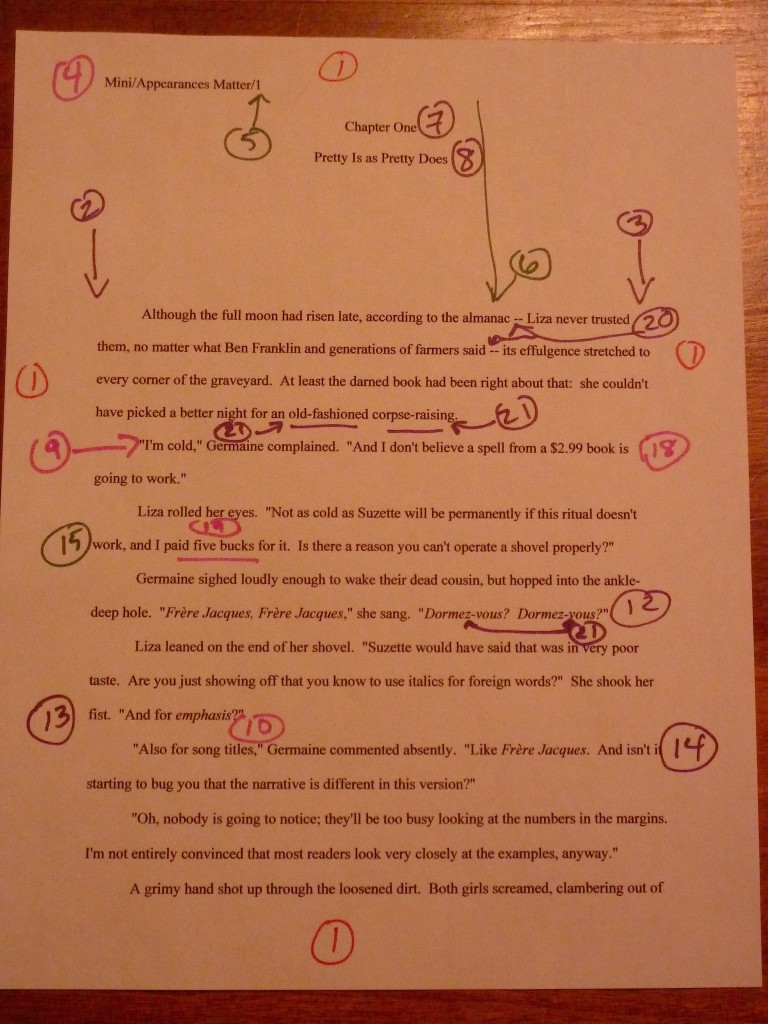


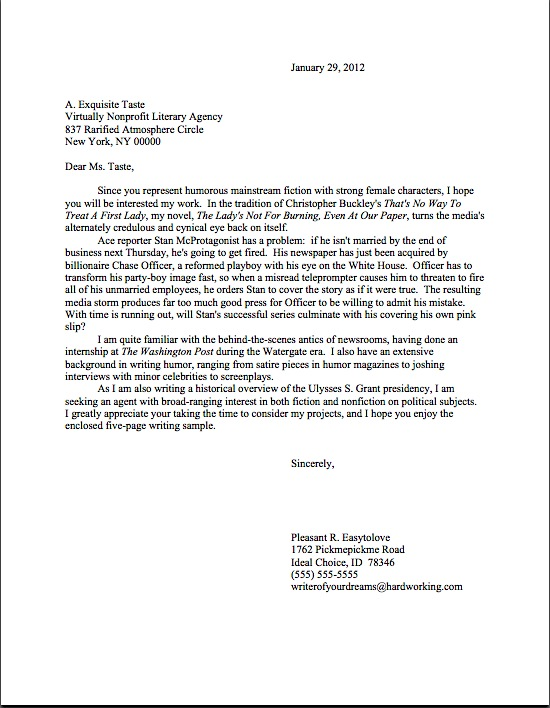
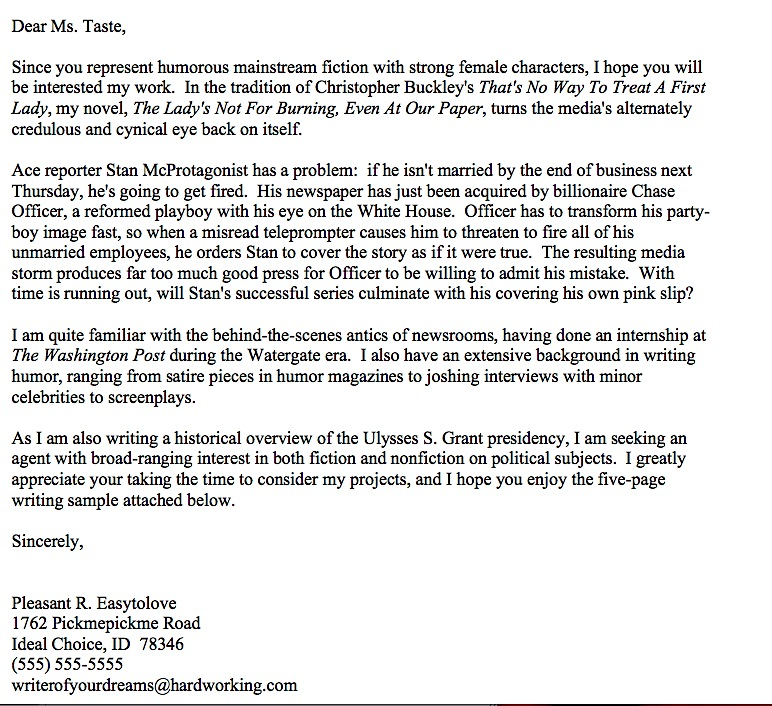
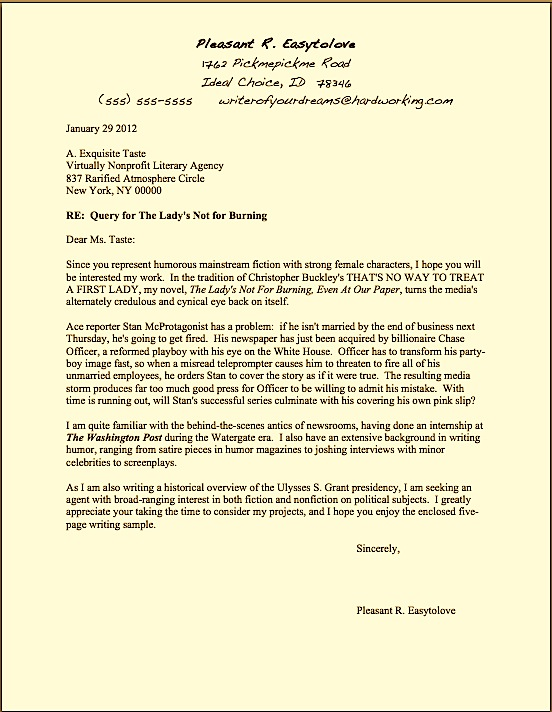
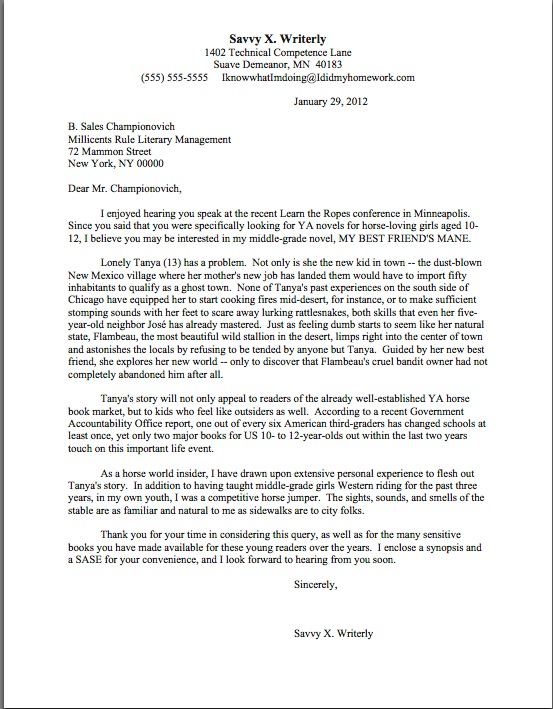
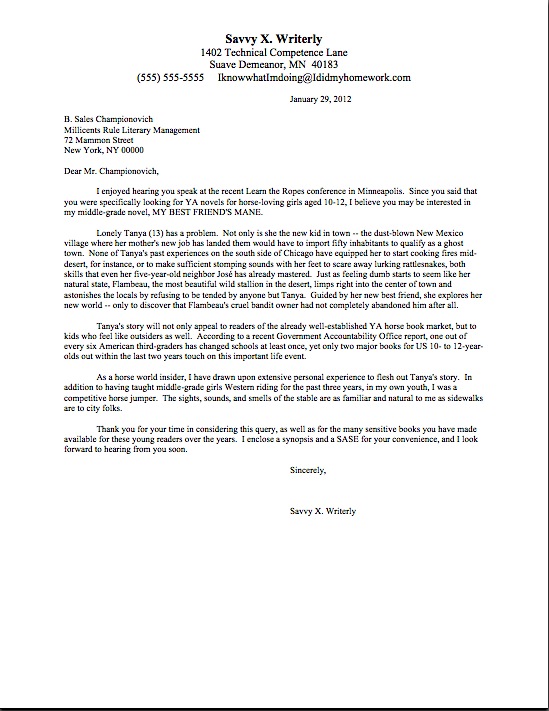
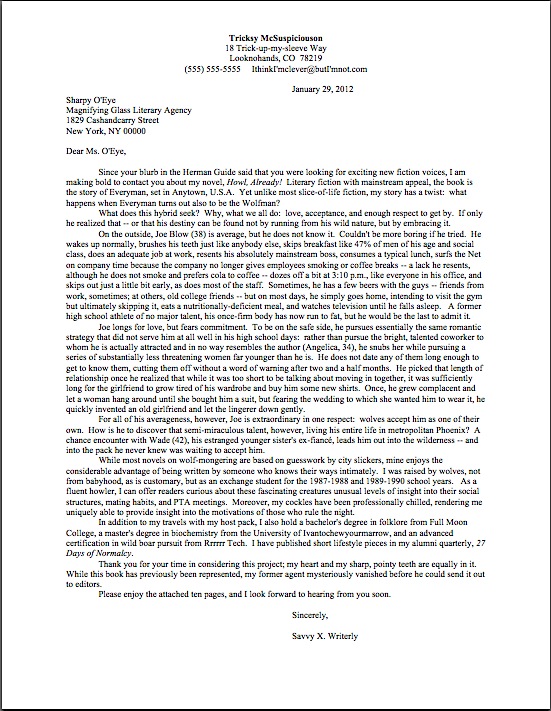
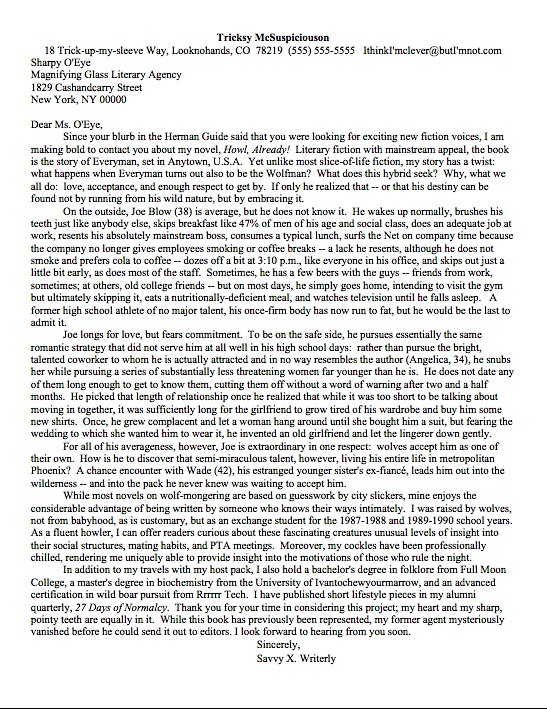
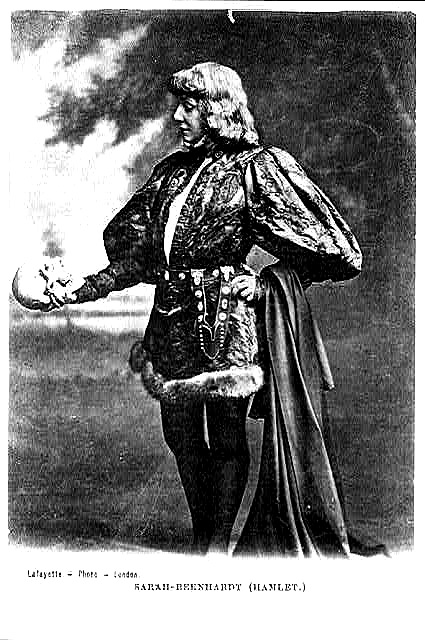
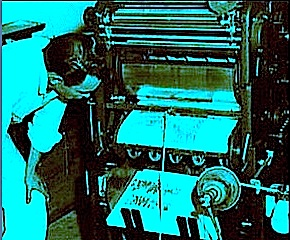



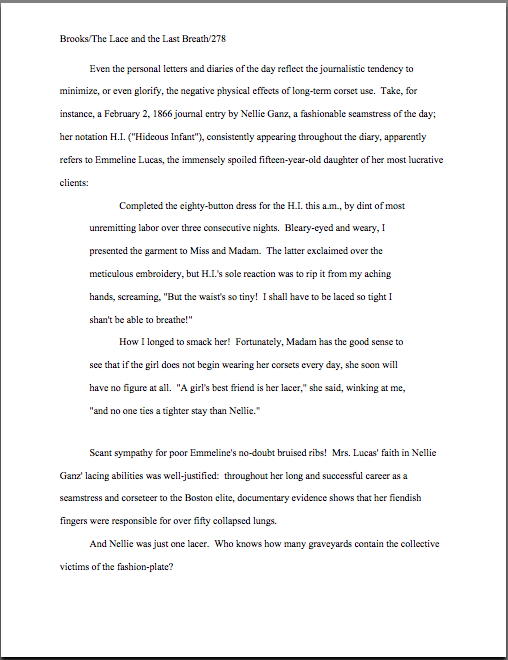
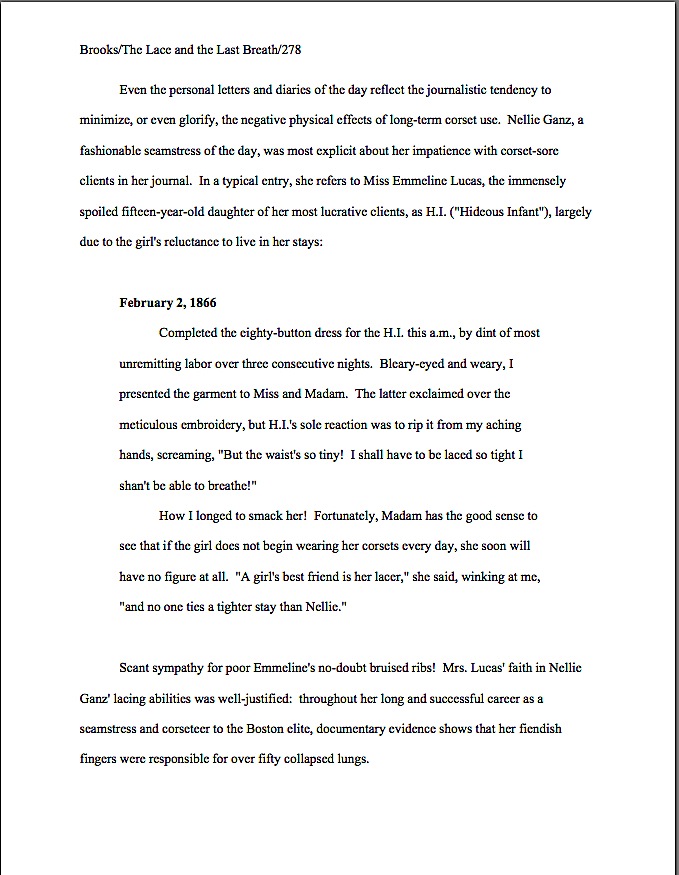
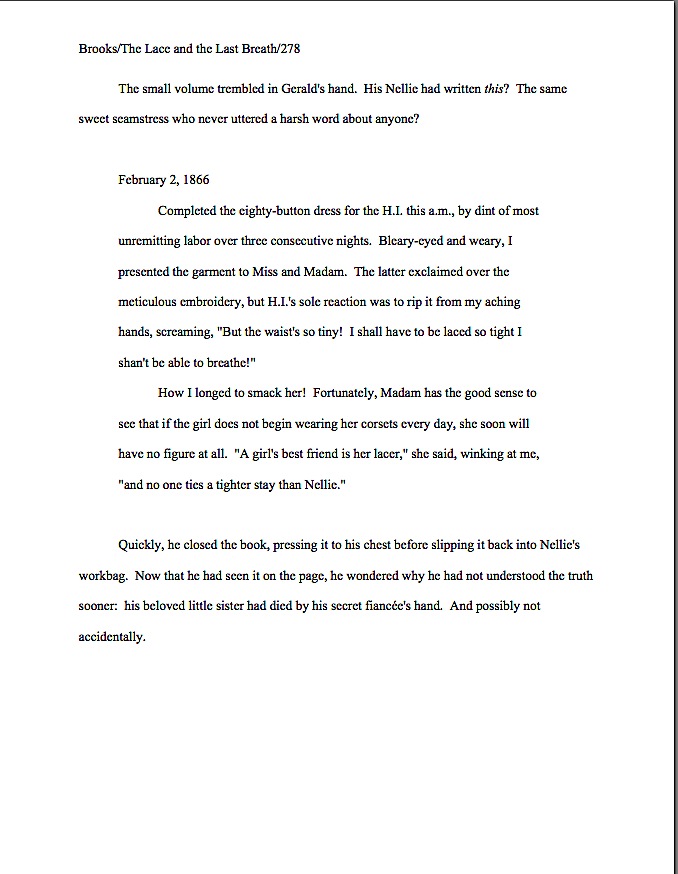
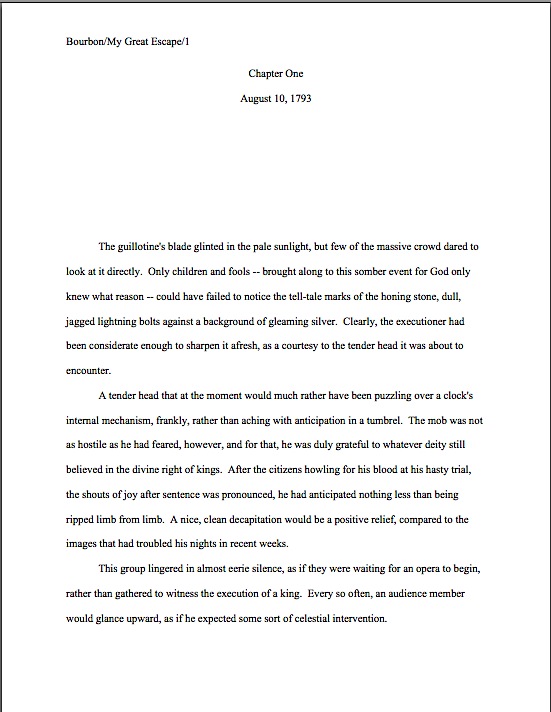
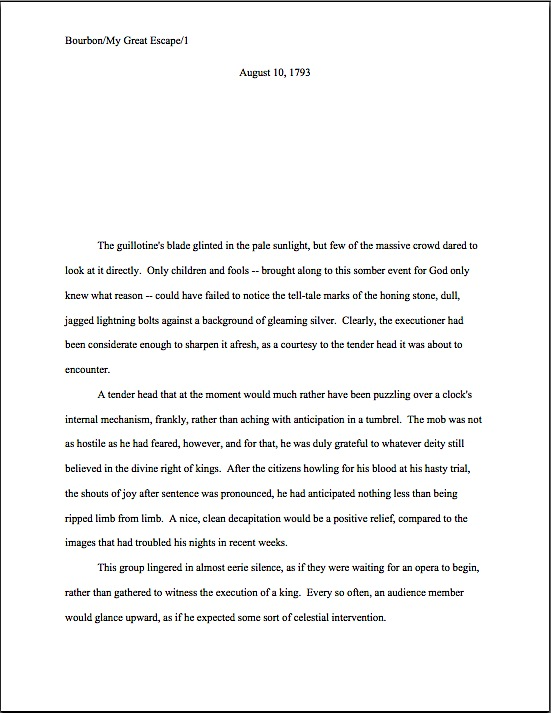
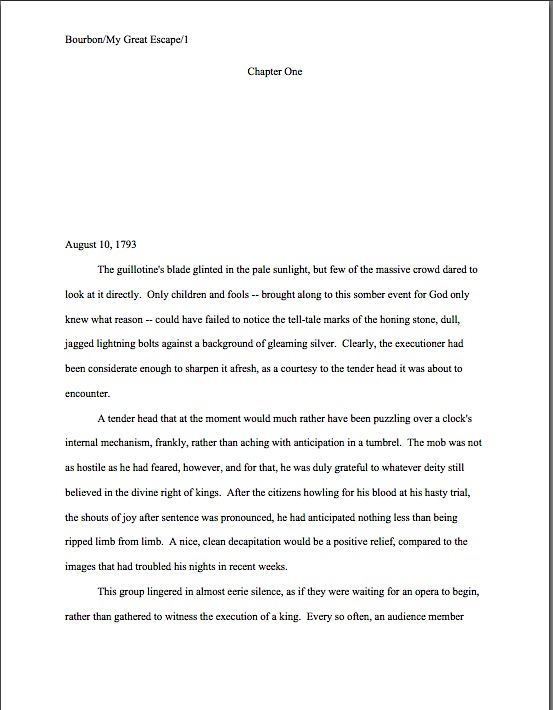
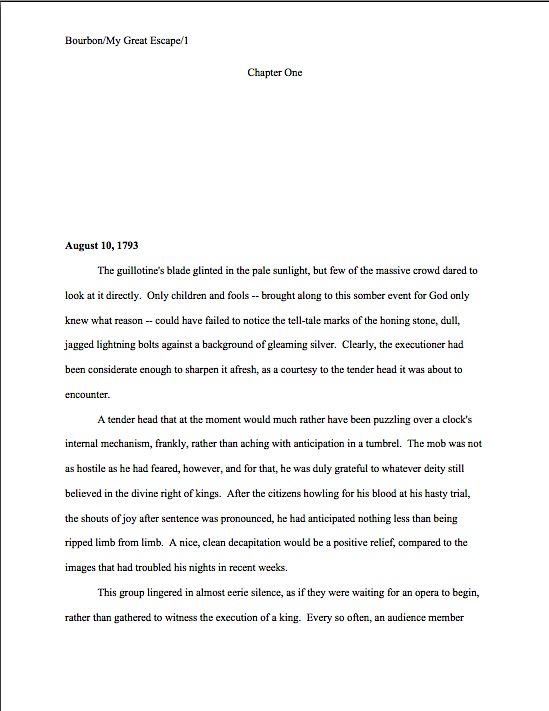



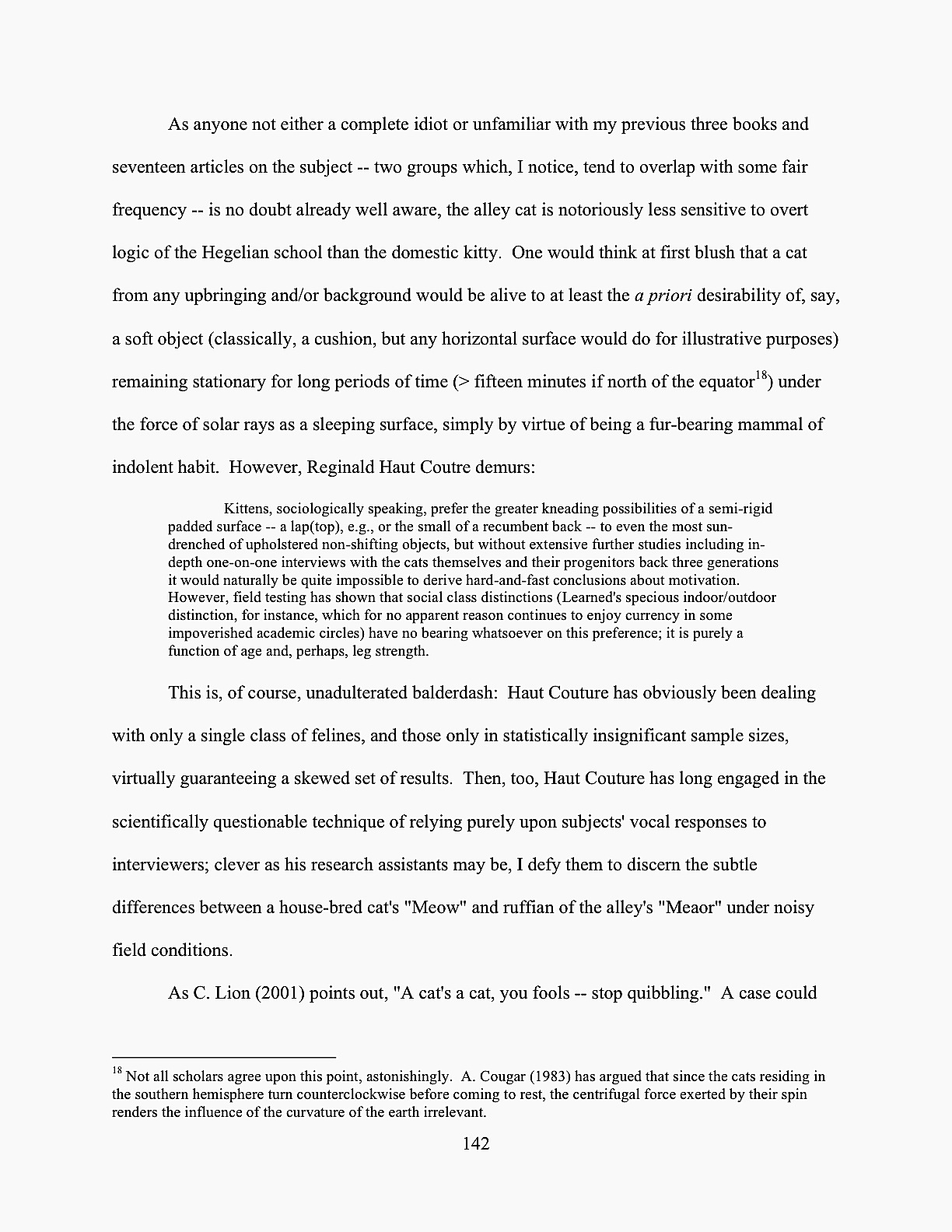

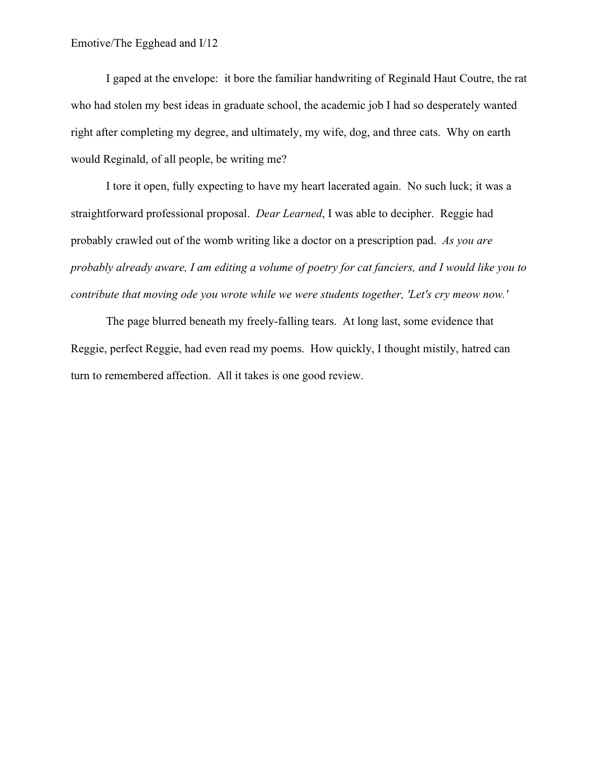

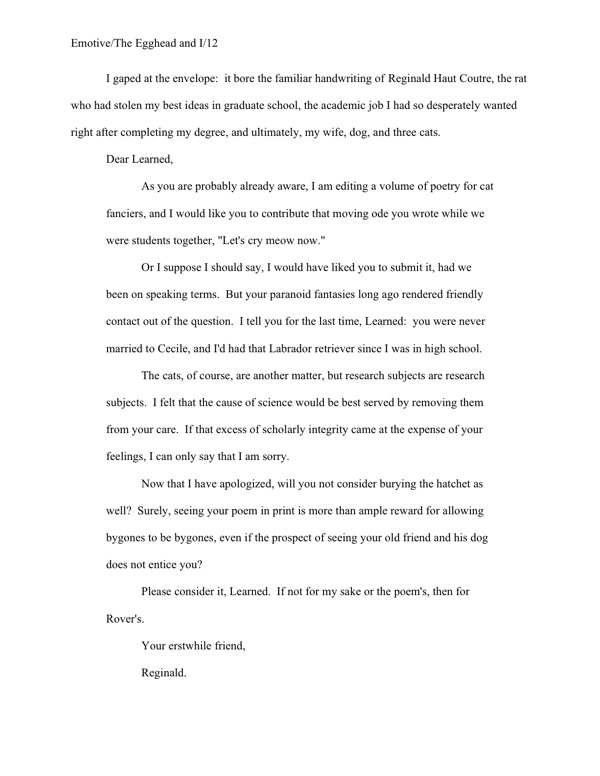

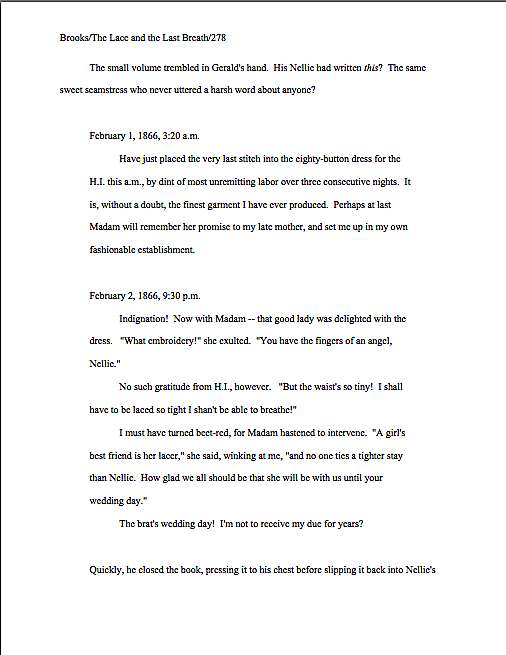

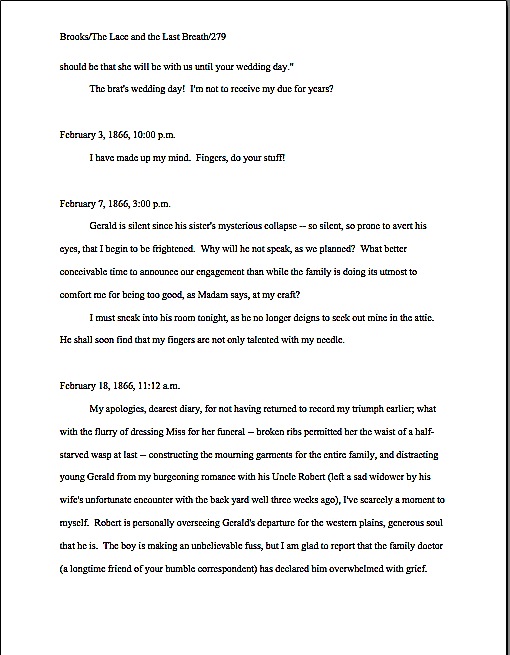

 Please recognize that not everything that falls under the general rubric writing should be formatted identically. Book manuscripts should be formatted one way, short stories (to use the most commonly-encountered other set of rules) another.
Please recognize that not everything that falls under the general rubric writing should be formatted identically. Book manuscripts should be formatted one way, short stories (to use the most commonly-encountered other set of rules) another. 


